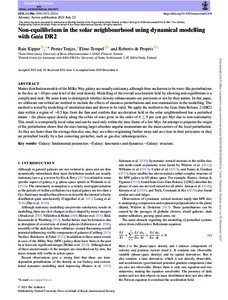Non-equilibrium in the solar neighbourhood using dynamical modelling with Gaia DR2
Kipper Rain; Tenjes Peeter; Tempel Elmo; de Propris Roberto
Non-equilibrium in the solar neighbourhood using dynamical modelling with Gaia DR2
Kipper Rain
Tenjes Peeter
Tempel Elmo
de Propris Roberto
OXFORD UNIV PRESS
Julkaisun pysyvä osoite on:
https://urn.fi/URN:NBN:fi-fe2021110554164
https://urn.fi/URN:NBN:fi-fe2021110554164
Tiivistelmä
Matter distribution models of the Milky Way galaxy are usually stationary, although there are known to be wave-like perturbations in the disc at similar to 10 per cent level of the total density. Modelling of the overall acceleration field by allowing non-equilibrium is a complicated task. We must learn to distinguish whether density enhancements are persistent or not by their nature. In this paper, we elaborate our orbital arc method to include the effects of massless perturbations and non-stationarities in the modelling. The method is tested by modelling of simulation data and shown to be valid. We apply the method to the Gaia Data Release 2 (DR2) data within a region of similar to 0.5 kpc from the Sun and confirm that acceleration field in the solar neighbourhood has a perturbed nature - the phase-space density along the orbits of stars grow in the order of k less than or similar to 5 per cent per Myr due to non-stationarity. This result is a temporally local value and can be used only within the time frame of a few Myr. An attempt to pinpoint the origin of the perturbation shows that the stars having larger absolute angular momentum are the main carriers of the local perturbation. As they are faster than the average thin disc star, they are either originating further away and are close in their pericentre or they are perturbed locally by a fast comoving perturber, such as gas disc inhomogeneities.
Kokoelmat
- Rinnakkaistallenteet [27094]
